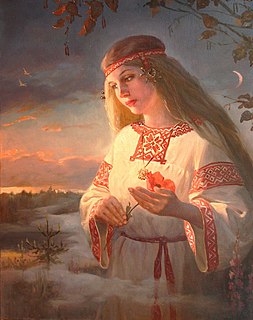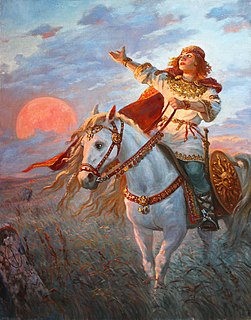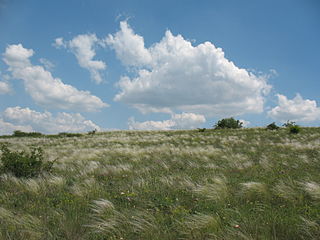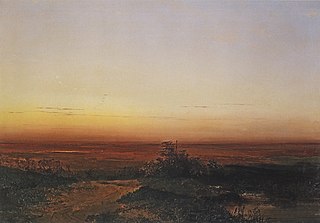In Latvian mythology, the term Māte stands for "mother", sometimes written in English as Mahte. It was an epithet applied to some sixty-seventy goddesses. They were clearly distinct goddesses in most or all cases, so the term definitely referred to the mother-goddess of specific phenomena. According to professor Lotte Motz, scholar Haralds Biezais mentioned there were at least 70 characters in Baltic religion identified with the title of Mate.

Romuva is a neo-pagan movement derived from the traditional mythology of the Lithuanians, attempting to reconstruct the religious rituals of the Lithuanians before their Christianization in 1387. Practitioners of Romuva claim to continue Baltic pagan traditions which survived in folklore, customs and superstition. Romuva is a polytheistic pagan faith which asserts the sanctity of nature and ancestor worship. Practicing the Romuva faith is seen by many adherents as a form of cultural pride, along with celebrating traditional forms of art, retelling Baltic folklore, practising traditional holidays, playing traditional Baltic music, singing traditional dainos (songs), as well as ecological activism and stewarding sacred places.

Svarog is a Slavic god of fire and blacksmithing, who was once interpreted as a sky god on the basis of an etymology rejected by modern scholarship. He is mentioned in only one source, the Primary Chronicle, which is problematic in interpretation. He is presented there as the Slavic equivalent of the Greek god Hephaestus. The meaning of his name is associated with fire. He is the father of Dazhbog and Svarozhits.

Zorya is a figure in Slavic folklore, a feminine personification of dawn, possibly goddess. Depending on tradition, she may appear as a singular entity, often called "The Red Maiden", or two or three sisters at once. Although Zorya is etymologically unrelated to the Proto-Indo-European goddess of the dawn *H₂éwsōs, she shares most of her characteristics. She is often depicted as the sister of the Sun, the Moon, and Zvezda, the Morning Star with which she is sometimes identified. She lives in the Palace of the Sun, opens the gate for him in the morning so that he can set off on a journey through the sky, guards his white horses, she is also described as a virgin. In the Eastern Slavic tradition of zagovory she represents the supreme power that a practitioner appeals to.

Proto-Indo-European mythology is the body of myths and deities associated with the Proto-Indo-Europeans, the hypothetical speakers of the reconstructed Proto-Indo-European language. Although the mythological motifs are not directly attested – since Proto-Indo-European speakers lived in preliterate societies – scholars of comparative mythology have reconstructed details from inherited similarities found among Indo-European languages, based on the assumption that parts of the Proto-Indo-Europeans' original belief systems survived in the daughter traditions.
Lithuanian mythology is the mythology of Lithuanian polytheism, the religion of pre-Christian Lithuanians. Like other Indo-Europeans, ancient Lithuanians maintained a polytheistic mythology and religious structure. In pre-Christian Lithuania, mythology was a part of polytheistic religion; after Christianisation mythology survived mostly in folklore, customs and festive rituals. Lithuanian mythology is very close to the mythology of other Baltic nations – Prussians, Latvians, and is considered a part of Baltic mythology.
Aušrinė is a feminine deity of the Morning Star (Venus) in the Lithuanian mythology. She is the antipode to "Vakarinė", the Evening Star.

Saulė is a solar goddess, the common Baltic solar deity in the Lithuanian and Latvian mythologies. The noun Saulė/Saule in the Lithuanian and Latvian languages is also the conventional name for the Sun and originates from the Proto-Baltic name *Sauliā > *Saulē.
Perkūnas was the common Baltic god of thunder, and the second most important deity in the Baltic pantheon after Dievas. In both Lithuanian and Latvian mythology, he is documented as the god of sky, thunder, lightning, storms, rain, fire, war, law, order, fertility, mountains, and oak trees.

Khors is a Slavic god of uncertain functions mentioned since the 12th century. Generally interpreted as a sun god, sometimes as a moon god. The meaning of the theonym is also unknown: most often his name has been combined with the Iranian word for sun, such as the Persian xoršid, or the Ossetian xor, but modern linguists strongly criticize such an etymology, and other native etymologies are proposed instead.

*Dyḗus, also *Dyḗus ph₂tḗr, is the reconstructed name of the daylight-sky god in Proto-Indo-European mythology. *Dyēus was conceived as a divine personification of the bright sky of the day and the seat of the gods, the *deywṓs. Associated with the vast diurnal sky and with the fertile rains, *Dyēus was often paired with *Dʰéǵʰōm, the Earth Mother, in a relationship of union and contrast.

h2éwsōs or haéusōs is the reconstructed Proto-Indo-European name of the dawn goddess in the Proto-Indo-European mythology.
Perëndi is the Albanian word for God, the sky and heaven. Perëndi is thought to have been a sky and thunder god in the Albanian pagan mythology, and to have been worshiped by the Illyrians in antiquity. His name has been retained in the Albanian language—along with the names Zot and Hyj —to refer to the Supreme Being after the spread of Christianity. Another archaic Albanian divine name of the sky and thunder god is Zojz, from PIE Dyeus (Daylight-Sky-God). In some of his attributes, Perëndi could be related to the weather and storm gods Shurdh and Verbt, and to the mythological demigod drangue.
Baltic mythology is the body of mythology of the Baltic people stemming from Baltic paganism and continuing after Christianization and into Baltic folklore. Baltic mythology ultimately stems from Proto-Indo-European mythology. The Baltic region was one of the last regions of Europe to be Christianized, a process that began in the 15th century and continued for at least a century afterward. While no native texts survive detailing the mythology of the Baltic peoples during the pagan period, knowledge of such beliefs may be gained from Russian and German chronicles, from later folklore, from etymology and from the reconstructions of comparative mythology.
Perkwunos is the reconstructed name of the weather god in Proto-Indo-European mythology. The deity was connected with fructifying rains, and his name probably invoked in times of drought. In a widespread Indo-European myth, the thunder-deity fights a multi-headed water-serpent during an epic battle, in order to release torrents of water that had previously been pent up. The name of his weapon, *meld-n-, which denoted both 'lightning' and 'hammer', can be reconstructed from the attested traditions.

The Divine Twins are youthful horsemen, either gods or demigods, who serve as rescuers and healers in Proto-Indo-European mythology.

The Prussian mythology was a polytheistic religion of the Old Prussians, indigenous peoples of Prussia before the Prussian Crusade waged by the Teutonic Knights. It was closely related to other Baltic faiths, the Lithuanian and Latvian mythologies. Its myths and legends did not survive as Prussians became Germanized and their culture extinct in the early 18th century. Fragmentary information on gods and rituals can be found in various medieval chronicles, but most of them are unreliable. No sources document pagan religion before the forced Christianization in the 13th century. Most of what is known about Prussian religion is obtained from dubious 16th-century sources.
Lithuanian Dievas, Latvian Dievs, Latgalian Dīvs, Prussian Dēiws, Yotvingian Deivas was the primordial supreme god in the Baltic mythology and one of the most important deities together with Perkūnas and he was brother of Potrimpo. He was the god of sky, prosperity, wealth, ruler of gods, and creator of universe. Dievas is a direct successor of the Proto-Indo-European supreme sky father god *Dyēus of the root *deiwo-. Its Proto-Baltic form was *Deivas.

In Slavic mythology, Perun is the highest god of the pantheon and the god of sky, thunder, lightning, storms, rain, law, war, fertility and oak trees. His other attributes were fire, mountains, wind, iris, eagle, firmament, horses and carts, weapons, and war. He was first associated with weapons made of stone and later with those of metal.











